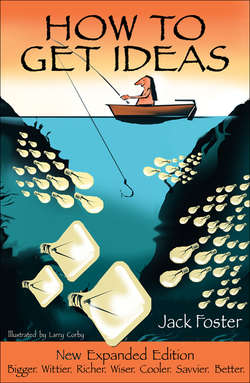Читать книгу How to Get Ideas - Jack Foster - Страница 2
На сайте Литреса книга снята с продажи.
Preface
ОглавлениеFor seven years I helped teach a 16-week class on advertising at the University of Southern California. The class was sponsored by the AAAA – American Association of Advertising Agencies – and was designed to give young people in advertising agencies an overview of the profession they had chosen.
One teacher talked about account management. One teacher talked about media and research. And I talked about creating advertising.
I talked about ads and commercials, about direct mail and outdoor advertising, about what makes good headlines and convincing body copy, about the use of music and jingles and product demonstrations and testimonials, about benefits and type selection and target audiences and copy points and subheads and strategy and teasers and coupons and free-standing inserts and psychographics and on and on and on.
And at the end of the first year I asked the graduates what I should have talked about but didn’t.
“Ideas,” they said. “You told us that every ad and every commercial should start with an idea,” one of them wrote, “but you never told us what an idea was or how to get one.”
Well.
So for the next six years I tried to talk about ideas and how to get them.
Not just advertising ideas. Ideas of all kinds.
After all, only a few of the people I taught were charged with coming up with ideas for ads and commercials; most were account executives and media planners and researchers, not writers and art directors. But all of them – just like you and everybody else in business and in government, in school and at home, be they beginners or veterans – need to know how to get ideas.
Why?
First, new ideas are the wheels of progress. Without them, stagnation reigns.
Whether you’re a designer dreaming of another world, an engineer working on a new kind of structure, an executive charged with developing a fresh business concept, an advertiser seeking a breakthrough way to sell your product, a fifth-grade teacher trying to plan a memorable school assembly program, or a volunteer looking for a new way to sell the same old raffle tickets, your ability to generate good ideas is critical to your success.
Second, computer systems are doing much of the mundane work you used to do, thereby (in theory at least) freeing you up – and indeed, requiring you – to do the creative work those systems can’t do.
Third, we live in an age so awash with information that at times we feel drowned in it, an age that demands a constant stream of new ideas if it is to reach its potential and realize its destiny.
That’s because information’s real value – aside from helping you understand things better – comes only when it is combined with other information to form new ideas: ideas that solve problems, ideas that help people, ideas that save and fix and create things, ideas that make things better and cheaper and more useful, ideas that enlighten and invigorate and inspire and enrich and embolden.
If you don’t use this fortune of information to create such ideas, you waste it.
In short, there’s never been a time in all of history when ideas were so needed or so valuable.
The first edition of this book contains most of what I told my students about ideas.
This second edition:
• Contains two new chapters – 5, Rejoice in Failure, and 8, Team Up with Energy – that were suggested by friends and by teachers and students who used the first edition as a textbook.
• Updates some of the examples and references and quotations to make the book more current.
• Is reorganized to make more clear the two parts of the book – Part I: Ten Ways to Idea-Condition Your Mind, and Part II: A Five-Step Method for Producing Ideas.
